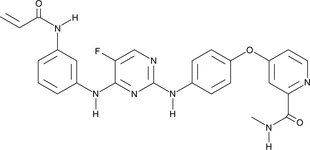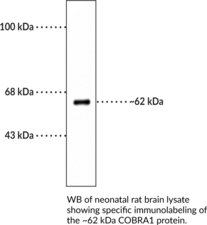Cayman
Showing 15901–16050 of 45550 results
-
CNQX is a competitive, non-NMDA glutamate receptor antagonist (IC50s = 0.3 and 1.5 μM for AMPA and kainate receptors, respectively, versus IC50 = 25 μM for NMDA receptors).{23071,23072} This compound has been used to specifically target AMPA and kainate receptor responses and thus differentiate from that of NMDA receptors.
Brand:CaymanSKU:-CNQX is a competitive, non-NMDA glutamate receptor antagonist (IC50s = 0.3 and 1.5 μM for AMPA and kainate receptors, respectively, versus IC50 = 25 μM for NMDA receptors).{23071,23072} This compound has been used to specifically target AMPA and kainate receptor responses and thus differentiate from that of NMDA receptors.
Brand:CaymanSKU:-CNQX is a competitive, non-NMDA glutamate receptor antagonist (IC50s = 0.3 and 1.5 μM for AMPA and kainate receptors, respectively, versus IC50 = 25 μM for NMDA receptors).{23071,23072} This compound has been used to specifically target AMPA and kainate receptor responses and thus differentiate from that of NMDA receptors.
Brand:CaymanSKU:-CNQX is a competitive, non-NMDA glutamate receptor antagonist (IC50s = 0.3 and 1.5 μM for AMPA and kainate receptors, respectively, versus IC50 = 25 μM for NMDA receptors).{23071,23072} This compound has been used to specifically target AMPA and kainate receptor responses and thus differentiate from that of NMDA receptors.
Brand:CaymanSKU:-CNX-1351 is a covalent inhibitor of PI3Kα (IC50 = 6.8 nM).{56002} It is selective for PI3Kα over PI3Kβ, -γ, and -δ (IC50s = 166, 240.3, and 3,020 nM, respectively), as well as PI3KC2A, PI3KC, PI4Kα, PI4Kβ, SPHK1, and SPHK2 (IC50s = >1 µM for all). CNX-1351 (500 nM) inhibits phosphorylation of Akt in SKOV3 cells. It inhibits the growth of SKOV3 and MCF-7 cancer cells (GI50s = 77.6 and 54.7 nM, respectively). CNX-1351 (100 mg/kg) inhibits Akt phosphorylation in mouse spleen.
Brand:CaymanSKU:30264 - 1 mgAvailable on backorder
CNX-1351 is a covalent inhibitor of PI3Kα (IC50 = 6.8 nM).{56002} It is selective for PI3Kα over PI3Kβ, -γ, and -δ (IC50s = 166, 240.3, and 3,020 nM, respectively), as well as PI3KC2A, PI3KC, PI4Kα, PI4Kβ, SPHK1, and SPHK2 (IC50s = >1 µM for all). CNX-1351 (500 nM) inhibits phosphorylation of Akt in SKOV3 cells. It inhibits the growth of SKOV3 and MCF-7 cancer cells (GI50s = 77.6 and 54.7 nM, respectively). CNX-1351 (100 mg/kg) inhibits Akt phosphorylation in mouse spleen.
Brand:CaymanSKU:30264 - 10 mgAvailable on backorder
CNX-1351 is a covalent inhibitor of PI3Kα (IC50 = 6.8 nM).{56002} It is selective for PI3Kα over PI3Kβ, -γ, and -δ (IC50s = 166, 240.3, and 3,020 nM, respectively), as well as PI3KC2A, PI3KC, PI4Kα, PI4Kβ, SPHK1, and SPHK2 (IC50s = >1 µM for all). CNX-1351 (500 nM) inhibits phosphorylation of Akt in SKOV3 cells. It inhibits the growth of SKOV3 and MCF-7 cancer cells (GI50s = 77.6 and 54.7 nM, respectively). CNX-1351 (100 mg/kg) inhibits Akt phosphorylation in mouse spleen.
Brand:CaymanSKU:30264 - 25 mgAvailable on backorder
CNX-1351 is a covalent inhibitor of PI3Kα (IC50 = 6.8 nM).{56002} It is selective for PI3Kα over PI3Kβ, -γ, and -δ (IC50s = 166, 240.3, and 3,020 nM, respectively), as well as PI3KC2A, PI3KC, PI4Kα, PI4Kβ, SPHK1, and SPHK2 (IC50s = >1 µM for all). CNX-1351 (500 nM) inhibits phosphorylation of Akt in SKOV3 cells. It inhibits the growth of SKOV3 and MCF-7 cancer cells (GI50s = 77.6 and 54.7 nM, respectively). CNX-1351 (100 mg/kg) inhibits Akt phosphorylation in mouse spleen.
Brand:CaymanSKU:30264 - 5 mgAvailable on backorder
CNX-2006 is an irreversible inhibitor of mutant EGFRs.{54404} It inhibits EGFR phosphorylation in PC-9 and HCC827 cells (IC50s = 55-104 nM), which express the EGFRDel E746_A750 mutation, and NCI H1975 and PC-9/GR4 cells (IC50s = 46 and 61 nM, respectively), which express the EGFRL858R/T790M and EGFRDel E746_A750/T790M mutations, respectively. It is greater than 10-fold selective for cells expressing these mutants over A549 cells expressing wild-type EGFR. CNX-2006 inhibits growth in a panel of non-small cell lung cancer (NSCLC) cells expressing wild-type or mutant EGFRs (GI50s = 0.34-8 and 0.003-3.6 μM, respectively). It reduces tumor growth in an NCI H1975 mouse xenograft model when administered at doses of 25 and 50 mg/kg.
Brand:CaymanSKU:30610 - 1 mgAvailable on backorder
CNX-2006 is an irreversible inhibitor of mutant EGFRs.{54404} It inhibits EGFR phosphorylation in PC-9 and HCC827 cells (IC50s = 55-104 nM), which express the EGFRDel E746_A750 mutation, and NCI H1975 and PC-9/GR4 cells (IC50s = 46 and 61 nM, respectively), which express the EGFRL858R/T790M and EGFRDel E746_A750/T790M mutations, respectively. It is greater than 10-fold selective for cells expressing these mutants over A549 cells expressing wild-type EGFR. CNX-2006 inhibits growth in a panel of non-small cell lung cancer (NSCLC) cells expressing wild-type or mutant EGFRs (GI50s = 0.34-8 and 0.003-3.6 μM, respectively). It reduces tumor growth in an NCI H1975 mouse xenograft model when administered at doses of 25 and 50 mg/kg.
Brand:CaymanSKU:30610 - 10 mgAvailable on backorder
CNX-2006 is an irreversible inhibitor of mutant EGFRs.{54404} It inhibits EGFR phosphorylation in PC-9 and HCC827 cells (IC50s = 55-104 nM), which express the EGFRDel E746_A750 mutation, and NCI H1975 and PC-9/GR4 cells (IC50s = 46 and 61 nM, respectively), which express the EGFRL858R/T790M and EGFRDel E746_A750/T790M mutations, respectively. It is greater than 10-fold selective for cells expressing these mutants over A549 cells expressing wild-type EGFR. CNX-2006 inhibits growth in a panel of non-small cell lung cancer (NSCLC) cells expressing wild-type or mutant EGFRs (GI50s = 0.34-8 and 0.003-3.6 μM, respectively). It reduces tumor growth in an NCI H1975 mouse xenograft model when administered at doses of 25 and 50 mg/kg.
Brand:CaymanSKU:30610 - 25 mgAvailable on backorder
CNX-2006 is an irreversible inhibitor of mutant EGFRs.{54404} It inhibits EGFR phosphorylation in PC-9 and HCC827 cells (IC50s = 55-104 nM), which express the EGFRDel E746_A750 mutation, and NCI H1975 and PC-9/GR4 cells (IC50s = 46 and 61 nM, respectively), which express the EGFRL858R/T790M and EGFRDel E746_A750/T790M mutations, respectively. It is greater than 10-fold selective for cells expressing these mutants over A549 cells expressing wild-type EGFR. CNX-2006 inhibits growth in a panel of non-small cell lung cancer (NSCLC) cells expressing wild-type or mutant EGFRs (GI50s = 0.34-8 and 0.003-3.6 μM, respectively). It reduces tumor growth in an NCI H1975 mouse xenograft model when administered at doses of 25 and 50 mg/kg.
Brand:CaymanSKU:30610 - 5 mgAvailable on backorder
CNX-774 is a potent, selective, and irreversible inhibitor of Bruton’s tyrosine kinase (BTK), an important kinase in the B cell antigen receptor pathway, with IC50 values of 50 = 2.82 and 0.38 µM) but has no effect on cell cycle progression.{34333}
Brand:CaymanSKU:21475 -Out of stock
CNX-774 is a potent, selective, and irreversible inhibitor of Bruton’s tyrosine kinase (BTK), an important kinase in the B cell antigen receptor pathway, with IC50 values of 50 = 2.82 and 0.38 µM) but has no effect on cell cycle progression.{34333}
Brand:CaymanSKU:21475 -Out of stock
CNX-774 is a potent, selective, and irreversible inhibitor of Bruton’s tyrosine kinase (BTK), an important kinase in the B cell antigen receptor pathway, with IC50 values of 50 = 2.82 and 0.38 µM) but has no effect on cell cycle progression.{34333}
Brand:CaymanSKU:21475 -Out of stock
CNX-774 is a potent, selective, and irreversible inhibitor of Bruton’s tyrosine kinase (BTK), an important kinase in the B cell antigen receptor pathway, with IC50 values of 50 = 2.82 and 0.38 µM) but has no effect on cell cycle progression.{34333}
Brand:CaymanSKU:21475 -Out of stock
CO-1686 is an irreversible kinase inhibitor that specifically targets mutant forms of the epidermal growth factor receptor (EGFR) including T790M (Ki = 21.5 nM) with significantly reduced activity at the wild-type form of the receptor (Ki = 303.3 nM).{27821} CO-1686 has been shown to inhibit the proliferation of non-small cell lung cancer (NSCLC) cells expressing mutant EGFR with GI50 values ranging from 7-32 nM in vitro, inducing apoptosis.{27821} It also demonstrates anti-tumor activity in NSCLC EGFR mutant xenograft and transgenic models dosed orally at 100 mg/kg/day.{27821}
Brand:CaymanSKU:-CO-1686 is an irreversible kinase inhibitor that specifically targets mutant forms of the epidermal growth factor receptor (EGFR) including T790M (Ki = 21.5 nM) with significantly reduced activity at the wild-type form of the receptor (Ki = 303.3 nM).{27821} CO-1686 has been shown to inhibit the proliferation of non-small cell lung cancer (NSCLC) cells expressing mutant EGFR with GI50 values ranging from 7-32 nM in vitro, inducing apoptosis.{27821} It also demonstrates anti-tumor activity in NSCLC EGFR mutant xenograft and transgenic models dosed orally at 100 mg/kg/day.{27821}
Brand:CaymanSKU:-CO-1686 is an irreversible kinase inhibitor that specifically targets mutant forms of the epidermal growth factor receptor (EGFR) including T790M (Ki = 21.5 nM) with significantly reduced activity at the wild-type form of the receptor (Ki = 303.3 nM).{27821} CO-1686 has been shown to inhibit the proliferation of non-small cell lung cancer (NSCLC) cells expressing mutant EGFR with GI50 values ranging from 7-32 nM in vitro, inducing apoptosis.{27821} It also demonstrates anti-tumor activity in NSCLC EGFR mutant xenograft and transgenic models dosed orally at 100 mg/kg/day.{27821}
Brand:CaymanSKU:-Cobicistat is an inhibitor of the cytochrome P450 (CYP) isomer CYP3A (IC50s = 30-285 nM for CYP3A metabolism of various HIV protease inhibitors).{41224} It is selective for CYP3A over other CYP isomers (IC50 = >25 μM for CYP1A2, 2C8, 2C9, and 2C19). Cobicistat does not inhibit HIV-1 protease (IC50 = >30 μM) or affect HIV replication in MT-2 cells (EC50 = >30 μM). Formulations containing cobicistat have been used to slow the metabolism of concomitantly administered protease inhibitors in the treatment of HIV.{41225}
Brand:CaymanSKU:23433 - 1 mgAvailable on backorder
Cobicistat is an inhibitor of the cytochrome P450 (CYP) isomer CYP3A (IC50s = 30-285 nM for CYP3A metabolism of various HIV protease inhibitors).{41224} It is selective for CYP3A over other CYP isomers (IC50 = >25 μM for CYP1A2, 2C8, 2C9, and 2C19). Cobicistat does not inhibit HIV-1 protease (IC50 = >30 μM) or affect HIV replication in MT-2 cells (EC50 = >30 μM). Formulations containing cobicistat have been used to slow the metabolism of concomitantly administered protease inhibitors in the treatment of HIV.{41225}
Brand:CaymanSKU:23433 - 10 mgAvailable on backorder
Cobicistat is an inhibitor of the cytochrome P450 (CYP) isomer CYP3A (IC50s = 30-285 nM for CYP3A metabolism of various HIV protease inhibitors).{41224} It is selective for CYP3A over other CYP isomers (IC50 = >25 μM for CYP1A2, 2C8, 2C9, and 2C19). Cobicistat does not inhibit HIV-1 protease (IC50 = >30 μM) or affect HIV replication in MT-2 cells (EC50 = >30 μM). Formulations containing cobicistat have been used to slow the metabolism of concomitantly administered protease inhibitors in the treatment of HIV.{41225}
Brand:CaymanSKU:23433 - 25 mgAvailable on backorder
Cobicistat is an inhibitor of the cytochrome P450 (CYP) isomer CYP3A (IC50s = 30-285 nM for CYP3A metabolism of various HIV protease inhibitors).{41224} It is selective for CYP3A over other CYP isomers (IC50 = >25 μM for CYP1A2, 2C8, 2C9, and 2C19). Cobicistat does not inhibit HIV-1 protease (IC50 = >30 μM) or affect HIV replication in MT-2 cells (EC50 = >30 μM). Formulations containing cobicistat have been used to slow the metabolism of concomitantly administered protease inhibitors in the treatment of HIV.{41225}
Brand:CaymanSKU:23433 - 5 mgAvailable on backorder
Cobimetinib is a potent, orally available inhibitor of MEK1 (IC50 = 4.2 nM).{27940,32043} It shows more than 100-fold selectivity for MEK when tested against a panel of more than 100 serine-threonine and tyrosine kinases. Cobimetinib induces differentiation and apoptosis in cancer cell lines and is more effective when combined with additional inhibitors, like PLX4032 (Item No. 10618).{32043,32044,32045}
Brand:CaymanSKU:-Available on backorder
Cobimetinib is a potent, orally available inhibitor of MEK1 (IC50 = 4.2 nM).{27940,32043} It shows more than 100-fold selectivity for MEK when tested against a panel of more than 100 serine-threonine and tyrosine kinases. Cobimetinib induces differentiation and apoptosis in cancer cell lines and is more effective when combined with additional inhibitors, like PLX4032 (Item No. 10618).{32043,32044,32045}
Brand:CaymanSKU:-Available on backorder
Cobimetinib is a potent, orally available inhibitor of MEK1 (IC50 = 4.2 nM).{27940,32043} It shows more than 100-fold selectivity for MEK when tested against a panel of more than 100 serine-threonine and tyrosine kinases. Cobimetinib induces differentiation and apoptosis in cancer cell lines and is more effective when combined with additional inhibitors, like PLX4032 (Item No. 10618).{32043,32044,32045}
Brand:CaymanSKU:-Available on backorder
Cobimetinib is a potent, orally available inhibitor of MEK1 (IC50 = 4.2 nM).{27940,32043} It shows more than 100-fold selectivity for MEK when tested against a panel of more than 100 serine-threonine and tyrosine kinases. Cobimetinib induces differentiation and apoptosis in cancer cell lines and is more effective when combined with additional inhibitors, like PLX4032 (Item No. 10618).{32043,32044,32045}
Brand:CaymanSKU:-Available on backorder
Immunogen: Recombinant human full-length COBRA1 expressed in E. coli• Host: Mouse • Species Reactivity: (+) Human, Mouse, Rat • Applications: WB • MW = ~62 kDa
Brand:CaymanSKU:29256- 100 µlCofactor of BRCA1 (COBRA1), also known as negative elongation factor B (NELFB), is a 580-amino acid nuclear protein encoded by NELFB in humans.{46946,46943} It induces chromosome decondensation by targeting lac operator-containing chromosome regions and is a component of NELF, a four-subunit complex that suppresses RNA polymerase II elongation in vitro. COBRA1 protein levels are enriched in mammary gland luminal epithelium, and it has a role in modulating estrogen-dependent and -independent expression of oncogenes in various breast cancer cell lines.{46943} Ectopic expression or knockdown of NELFB suppresses or accelerates breast cancer cell growth, respectively, as well as enhances androgen-mediated transcription.{46943,46944} COBRA1 also interacts with the activated protein-1 (AP-1) family members c-Jun and c-Fos, and inhibits AP-1-mediated transcription in vitro.{46945} Cayman’s COBRA1 Monoclonal Antibody can be used for Western blot (WB) applications. The antibody recognizes COBRA1 at approximately 62 kDa from human, mouse, and rat samples.
Brand:CaymanSKU:29256 - 100 µlAvailable on backorder
Immunogen: Recombinant human full-length COBRA1 expressed in E. coli• Host: Mouse • Species Reactivity: (+) Human, Mouse, Rat • Applications: WB • MW = ~62 kDa
Brand:CaymanSKU:29256- 100 µlAvailable on backorder
Cochlioquinone A, a bioactive compound isolated from D. sacchari and Bipolaris sp., is an inhibitor of diacylglycerol kinase (DGK; Ki = 3.1 µM) and diacylglycerol acyltransferase (DGAT; IC50 = 5.6 µM).{31097,31096,31098} It has been shown to reduce the concentration of phosphatidic acid in T cell lymphoma with an IC50 value of 3 µM.{31097} It is also reported to compete with macrophage inflammatory protein-1α for binding to human CCR5 chemokine receptors with an IC50 value of 11 µM.{31098}
Brand:CaymanSKU:-Available on backorder
Cochlioquinone A, a bioactive compound isolated from D. sacchari and Bipolaris sp., is an inhibitor of diacylglycerol kinase (DGK; Ki = 3.1 µM) and diacylglycerol acyltransferase (DGAT; IC50 = 5.6 µM).{31097,31096,31098} It has been shown to reduce the concentration of phosphatidic acid in T cell lymphoma with an IC50 value of 3 µM.{31097} It is also reported to compete with macrophage inflammatory protein-1α for binding to human CCR5 chemokine receptors with an IC50 value of 11 µM.{31098}
Brand:CaymanSKU:-Available on backorder
Cochlioquinone is a sesquiterpene metabolite originally isolated from C. miyabeanus.{39758} It is a phytotoxin that inhibits root growth of finger millet (E. coracana) and rice plants (O. sativa) by 59.9 and 51.7%, respectively, when used at a concentration of 100 ppm.{39759} Cochlioquinone B inhibits NADH oxidase and NADH-2,3-dimethoxy-5-pentyl-1,4-benzoquinone reductase from bovine heart mitochondria.{39760}
Brand:CaymanSKU:25121 - 2.5 mgAvailable on backorder
Cochlioquinone is a sesquiterpene metabolite originally isolated from C. miyabeanus.{39758} It is a phytotoxin that inhibits root growth of finger millet (E. coracana) and rice plants (O. sativa) by 59.9 and 51.7%, respectively, when used at a concentration of 100 ppm.{39759} Cochlioquinone B inhibits NADH oxidase and NADH-2,3-dimethoxy-5-pentyl-1,4-benzoquinone reductase from bovine heart mitochondria.{39760}
Brand:CaymanSKU:25121 - 500 µgAvailable on backorder
Codeinone (Item No. 29917) is an analytical reference standard that is structurally similar to known opioids.{53237} It is a precursor in the synthesis of hydrocodone (Item Nos. ISO60144 | 15461 | 22166) and oxycodone (Item Nos. ISO60148 | 15465 | 26513). This product is intended for research and forensic applications.
Brand:CaymanSKU:29917 - 1 mgAvailable on backorder
Codeinone (Item No. 29917) is an analytical reference standard that is structurally similar to known opioids.{53237} It is a precursor in the synthesis of hydrocodone (Item Nos. ISO60144 | 15461 | 22166) and oxycodone (Item Nos. ISO60148 | 15465 | 26513). This product is intended for research and forensic applications.
Brand:CaymanSKU:29917 - 5 mgAvailable on backorder
Coelenterazine is a luciferin, a light-emitting biomolecule that serves as a substrate for luciferases or as a constituent of photoproteins, including aequorin.{22804} The oxidation of coelenterazine to coelenteramide is accompanied by emission of blue light (emission maximum, 460-470 nm). Luciferase-mediated oxidation of coelenterazine or a derivative is used as an energy donor, typically to a form of green or yellow fluorescent protein, in bioluminescent resonance energy transfer studies.{26296,26290} Alternatively, the calcium-mediated release of coelenterazine from aequorin, followed by non-enzymatic oxidation of this compound, results in bioluminescence. As light emission depends on both calcium and cellular redox status, this reaction is used to non-fluorescently detect changes in calcium level and redox status.{5885,6107}
Brand:CaymanSKU:-Coelenterazine is a luciferin, a light-emitting biomolecule that serves as a substrate for luciferases or as a constituent of photoproteins, including aequorin.{22804} The oxidation of coelenterazine to coelenteramide is accompanied by emission of blue light (emission maximum, 460-470 nm). Luciferase-mediated oxidation of coelenterazine or a derivative is used as an energy donor, typically to a form of green or yellow fluorescent protein, in bioluminescent resonance energy transfer studies.{26296,26290} Alternatively, the calcium-mediated release of coelenterazine from aequorin, followed by non-enzymatic oxidation of this compound, results in bioluminescence. As light emission depends on both calcium and cellular redox status, this reaction is used to non-fluorescently detect changes in calcium level and redox status.{5885,6107}
Brand:CaymanSKU:-Coelenterazine is a luciferin, a light-emitting biomolecule that serves as a substrate for luciferases or as a constituent of photoproteins, including aequorin.{22804} The oxidation of coelenterazine to coelenteramide is accompanied by emission of blue light (emission maximum, 460-470 nm). Luciferase-mediated oxidation of coelenterazine or a derivative is used as an energy donor, typically to a form of green or yellow fluorescent protein, in bioluminescent resonance energy transfer studies.{26296,26290} Alternatively, the calcium-mediated release of coelenterazine from aequorin, followed by non-enzymatic oxidation of this compound, results in bioluminescence. As light emission depends on both calcium and cellular redox status, this reaction is used to non-fluorescently detect changes in calcium level and redox status.{5885,6107}
Brand:CaymanSKU:-Coelenterazine 400a is a bisdeoxy derivative of coelenterazine (Item No. 16123) that displays an emission maximum of 395 nm following conversion by Renilla luciferase (Rluc).{26297,26291} It is used in bioluminescence resonance energy transfer 2 (BRET2) protocols, whereas coelenterazine h (Item No. 16894), which displays an emission maximum of 475 nm upon conversion by Rluc, is used in BRET1 protocols.{26296} Coelenterazine 400a is commonly paired with class 1 and 3 GFP acceptors, including GFP2 and GFP10.{26291,26296} BRET2 assays are commonly used in evaluating protein-protein interactions, including those involved in G protein-coupled receptor signaling.{26297,26291,26294}
Brand:CaymanSKU:-Coelenterazine 400a is a bisdeoxy derivative of coelenterazine (Item No. 16123) that displays an emission maximum of 395 nm following conversion by Renilla luciferase (Rluc).{26297,26291} It is used in bioluminescence resonance energy transfer 2 (BRET2) protocols, whereas coelenterazine h (Item No. 16894), which displays an emission maximum of 475 nm upon conversion by Rluc, is used in BRET1 protocols.{26296} Coelenterazine 400a is commonly paired with class 1 and 3 GFP acceptors, including GFP2 and GFP10.{26291,26296} BRET2 assays are commonly used in evaluating protein-protein interactions, including those involved in G protein-coupled receptor signaling.{26297,26291,26294}
Brand:CaymanSKU:-Coelenterazine 400a is a bisdeoxy derivative of coelenterazine (Item No. 16123) that displays an emission maximum of 395 nm following conversion by Renilla luciferase (Rluc).{26297,26291} It is used in bioluminescence resonance energy transfer 2 (BRET2) protocols, whereas coelenterazine h (Item No. 16894), which displays an emission maximum of 475 nm upon conversion by Rluc, is used in BRET1 protocols.{26296} Coelenterazine 400a is commonly paired with class 1 and 3 GFP acceptors, including GFP2 and GFP10.{26291,26296} BRET2 assays are commonly used in evaluating protein-protein interactions, including those involved in G protein-coupled receptor signaling.{26297,26291,26294}
Brand:CaymanSKU:-Coelenterazine 400a is a bisdeoxy derivative of coelenterazine (Item No. 16123) that displays an emission maximum of 395 nm following conversion by Renilla luciferase (Rluc).{26297,26291} It is used in bioluminescence resonance energy transfer 2 (BRET2) protocols, whereas coelenterazine h (Item No. 16894), which displays an emission maximum of 475 nm upon conversion by Rluc, is used in BRET1 protocols.{26296} Coelenterazine 400a is commonly paired with class 1 and 3 GFP acceptors, including GFP2 and GFP10.{26291,26296} BRET2 assays are commonly used in evaluating protein-protein interactions, including those involved in G protein-coupled receptor signaling.{26297,26291,26294}
Brand:CaymanSKU:25738 - 1 mgAvailable on backorder
Coelenterazine 400a is a bisdeoxy derivative of coelenterazine (Item No. 16123) that displays an emission maximum of 395 nm following conversion by Renilla luciferase (Rluc).{26297,26291} It is used in bioluminescence resonance energy transfer 2 (BRET2) protocols, whereas coelenterazine h (Item No. 16894), which displays an emission maximum of 475 nm upon conversion by Rluc, is used in BRET1 protocols.{26296} Coelenterazine 400a is commonly paired with class 1 and 3 GFP acceptors, including GFP2 and GFP10.{26291,26296} BRET2 assays are commonly used in evaluating protein-protein interactions, including those involved in G protein-coupled receptor signaling.{26297,26291,26294}
Brand:CaymanSKU:25738 - 5 mgAvailable on backorder
Coelenterazine 400a is a bisdeoxy derivative of coelenterazine (Item No. 16123) that displays an emission maximum of 395 nm following conversion by Renilla luciferase (Rluc).{26297,26291} It is used in bioluminescence resonance energy transfer 2 (BRET2) protocols, whereas coelenterazine h (Item No. 16894), which displays an emission maximum of 475 nm upon conversion by Rluc, is used in BRET1 protocols.{26296} Coelenterazine 400a is commonly paired with class 1 and 3 GFP acceptors, including GFP2 and GFP10.{26291,26296} BRET2 assays are commonly used in evaluating protein-protein interactions, including those involved in G protein-coupled receptor signaling.{26297,26291,26294}
Brand:CaymanSKU:25738 - 500 µgAvailable on backorder
Coelenterazine (Item No. 16123) is a luciferin, a light-emitting biomolecule that serves as a substrate for luciferases or as a constituent of photoproteins, including aequorin.{22804} Coelenterazine can be used to reconstitute the aequorin complex both in vivo and in vitro, emitting blue light when bound to calcium ions. Coelenterazine h is a synthetic derivative of native coelenterazine that exhibits 16-fold higher luminescence intensity (emission maximum ~466 nm; half-total time of 0.6-1.2 sec) than native coelenterazine.{6107} Aequorin complexes reconstituted with coelenterazine h are reported to be more sensitive to calcium ions than those employing the native constituent, providing a useful indicator for small changes in Ca2+ concentrations.{27442}
Brand:CaymanSKU:-Out of stock
Coelenterazine (Item No. 16123) is a luciferin, a light-emitting biomolecule that serves as a substrate for luciferases or as a constituent of photoproteins, including aequorin.{22804} Coelenterazine can be used to reconstitute the aequorin complex both in vivo and in vitro, emitting blue light when bound to calcium ions. Coelenterazine h is a synthetic derivative of native coelenterazine that exhibits 16-fold higher luminescence intensity (emission maximum ~466 nm; half-total time of 0.6-1.2 sec) than native coelenterazine.{6107} Aequorin complexes reconstituted with coelenterazine h are reported to be more sensitive to calcium ions than those employing the native constituent, providing a useful indicator for small changes in Ca2+ concentrations.{27442}
Brand:CaymanSKU:-Out of stock
Coenzyme A (CoA) is an essential cofactor functioning as an acyl group carrier and carbonyl-activating group for the citric acid cycle and fatty acid metabolism.{18936} About 4% of cellular enzymes utilize CoA as a substrate. It is synthesized from pantothenic acid in a 5-step process that requires ATP.{18938} The pantothenate kinase step of the CoA biosynthetic pathway has been identified as a target for the development of antibacterial compounds.{18937}
Brand:CaymanSKU:-Coenzyme A (CoA) is an essential cofactor functioning as an acyl group carrier and carbonyl-activating group for the citric acid cycle and fatty acid metabolism.{18936} About 4% of cellular enzymes utilize CoA as a substrate. It is synthesized from pantothenic acid in a 5-step process that requires ATP.{18938} The pantothenate kinase step of the CoA biosynthetic pathway has been identified as a target for the development of antibacterial compounds.{18937}
Brand:CaymanSKU:-Coenzyme A (CoA) is an essential cofactor functioning as an acyl group carrier and carbonyl-activating group for the citric acid cycle and fatty acid metabolism.{18936} About 4% of cellular enzymes utilize CoA as a substrate. It is synthesized from pantothenic acid in a 5-step process that requires ATP.{18938} The pantothenate kinase step of the CoA biosynthetic pathway has been identified as a target for the development of antibacterial compounds.{18937}
Brand:CaymanSKU:-Cooenzyme Q10 (CoQ10) is a component of the electron transport chain and participates in aerobic cellular respiration, generating energy in the form of ATP.{20670} CoQ1 is an amphipathic CoQ10 homolog that has a tail consisting of five isoprene units. It has been used as an electron acceptor to study a range of oxidoreductases as isolated enzymes, in subcellular fractions, in intact cells in culture, and in perfused organs.{30187,30291,30292} Ubiquinone analogs, including CoQ1, impact mitochondrial permeability transition pore (PTP) formation, as well as PTP-dependent cell death, in an analog- and cell-specific manner.{30293}
Brand:CaymanSKU:-Available on backorder
Cooenzyme Q10 (CoQ10) is a component of the electron transport chain and participates in aerobic cellular respiration, generating energy in the form of ATP.{20670} CoQ1 is an amphipathic CoQ10 homolog that has a tail consisting of five isoprene units. It has been used as an electron acceptor to study a range of oxidoreductases as isolated enzymes, in subcellular fractions, in intact cells in culture, and in perfused organs.{30187,30291,30292} Ubiquinone analogs, including CoQ1, impact mitochondrial permeability transition pore (PTP) formation, as well as PTP-dependent cell death, in an analog- and cell-specific manner.{30293}
Brand:CaymanSKU:-Available on backorder
Cooenzyme Q10 (CoQ10) is a component of the electron transport chain and participates in aerobic cellular respiration, generating energy in the form of ATP.{20670} CoQ1 is an amphipathic CoQ10 homolog that has a tail consisting of five isoprene units. It has been used as an electron acceptor to study a range of oxidoreductases as isolated enzymes, in subcellular fractions, in intact cells in culture, and in perfused organs.{30187,30291,30292} Ubiquinone analogs, including CoQ1, impact mitochondrial permeability transition pore (PTP) formation, as well as PTP-dependent cell death, in an analog- and cell-specific manner.{30293}
Brand:CaymanSKU:-Available on backorder
Coenzyme Q10 (CoQ10) is a naturally occurring quinone found throughout the body in cell membranes, primarily in mitochondrial membranes, with highest concentrations in the heart, lungs, liver, kidneys, spleen, pancreas, and adrenal glands.{20672} It is a component of the electron transport chain and participates in aerobic cellular respiration, generating energy in the form of ATP.{20670} In its reduced form, CoQ10 acts as an antioxidant, preventing the formation of reactive oxygen species.{20670} CoQ10 deficiencies have been associated with heart failure, hypertension, parkinsonism, mitochondrial encephalomyopathies, and other chronic diseases.{20669,20671}
Brand:CaymanSKU:11506 - 1 gAvailable on backorder
Coenzyme Q10 (CoQ10) is a naturally occurring quinone found throughout the body in cell membranes, primarily in mitochondrial membranes, with highest concentrations in the heart, lungs, liver, kidneys, spleen, pancreas, and adrenal glands.{20672} It is a component of the electron transport chain and participates in aerobic cellular respiration, generating energy in the form of ATP.{20670} In its reduced form, CoQ10 acts as an antioxidant, preventing the formation of reactive oxygen species.{20670} CoQ10 deficiencies have been associated with heart failure, hypertension, parkinsonism, mitochondrial encephalomyopathies, and other chronic diseases.{20669,20671}
Brand:CaymanSKU:11506 - 100 mgAvailable on backorder
Coenzyme Q10 (CoQ10) is a naturally occurring quinone found throughout the body in cell membranes, primarily in mitochondrial membranes, with highest concentrations in the heart, lungs, liver, kidneys, spleen, pancreas, and adrenal glands.{20672} It is a component of the electron transport chain and participates in aerobic cellular respiration, generating energy in the form of ATP.{20670} In its reduced form, CoQ10 acts as an antioxidant, preventing the formation of reactive oxygen species.{20670} CoQ10 deficiencies have been associated with heart failure, hypertension, parkinsonism, mitochondrial encephalomyopathies, and other chronic diseases.{20669,20671}
Brand:CaymanSKU:11506 - 200 mgAvailable on backorder
Coenzyme Q10-d6 (CoQ10-d6) is intended for use as an internal standard for the quantification of CoQ10 (Item No. 11506) by GC- or LC-MS. CoQ10 is a naturally occurring quinone found throughout the body in cell membranes, primarily in mitochondrial membranes, with highest concentrations in the heart, lungs, liver, kidneys, spleen, pancreas, and adrenal glands.{20672} It is a component of the electron transport chain and participates in aerobic cellular respiration, generating energy in the form of ATP.{20670} In its reduced form, CoQ10 acts as an antioxidant, preventing the formation of reactive oxygen species.{20670} CoQ10 deficiencies have been associated with heart failure, hypertension, parkinsonism, mitochondrial encephalomyopathies, and other chronic diseases.{20669,20671}
Brand:CaymanSKU:30958 - 1 mgAvailable on backorder
Coenzyme Q10 (Item No. 11506) is a component of the electron transport chain and participates in aerobic cellular respiration, generating energy in the form of ATP.{20670} In its reduced form, it acts as an antioxidant.{20670} Coenzyme Q2 is a precursor of coenzyme Q10 that has 2, rather than 10, isoprenoid units on the ubiquinone base. It can act as an electron acceptor for bacterial Complex I.{30185} In mammalian cells, exogenous coenzyme Q2 prevents the production of reactive oxygen species associated with Complex I activity.{30187,24936} Forms of coenzyme Q with shorter isoprenoid chains, including coenzyme Q2, induce p53-dependent apoptosis in human B-cell acute lymphoblastoid leukemia BALL-1 cells.{30186}
Brand:CaymanSKU:-Available on backorder
Coenzyme Q10 (Item No. 11506) is a component of the electron transport chain and participates in aerobic cellular respiration, generating energy in the form of ATP.{20670} In its reduced form, it acts as an antioxidant.{20670} Coenzyme Q2 is a precursor of coenzyme Q10 that has 2, rather than 10, isoprenoid units on the ubiquinone base. It can act as an electron acceptor for bacterial Complex I.{30185} In mammalian cells, exogenous coenzyme Q2 prevents the production of reactive oxygen species associated with Complex I activity.{30187,24936} Forms of coenzyme Q with shorter isoprenoid chains, including coenzyme Q2, induce p53-dependent apoptosis in human B-cell acute lymphoblastoid leukemia BALL-1 cells.{30186}
Brand:CaymanSKU:-Available on backorder
Coenzyme Q10 (Item No. 11506) is a component of the electron transport chain and participates in aerobic cellular respiration, generating energy in the form of ATP.{20670} In its reduced form, it acts as an antioxidant.{20670} Coenzyme Q2 is a precursor of coenzyme Q10 that has 2, rather than 10, isoprenoid units on the ubiquinone base. It can act as an electron acceptor for bacterial Complex I.{30185} In mammalian cells, exogenous coenzyme Q2 prevents the production of reactive oxygen species associated with Complex I activity.{30187,24936} Forms of coenzyme Q with shorter isoprenoid chains, including coenzyme Q2, induce p53-dependent apoptosis in human B-cell acute lymphoblastoid leukemia BALL-1 cells.{30186}
Brand:CaymanSKU:-Available on backorder
Coenzyme Q9 (CoQ9) is a nine isoprenyl group-containing member of the mitochondrial ubiquinone family that is thought to be necessary for the biosynthesis of CoQ10 (Item No. 11506) in humans. Mutations in the gene that encodes CoQ9 are associated with encephalomyopathy and autosomal-recessive, neonatal-onset, primary CoQ10 deficiency.{27490,27492} While in humans CoQ10 predominates, mice and C. elegans primarily rely on CoQ9 for electron transport through the mitochondrial respiratory chain and for antioxidant functions.{27491}
Brand:CaymanSKU:-Out of stock
Coenzyme Q9 (CoQ9) is a nine isoprenyl group-containing member of the mitochondrial ubiquinone family that is thought to be necessary for the biosynthesis of CoQ10 (Item No. 11506) in humans. Mutations in the gene that encodes CoQ9 are associated with encephalomyopathy and autosomal-recessive, neonatal-onset, primary CoQ10 deficiency.{27490,27492} While in humans CoQ10 predominates, mice and C. elegans primarily rely on CoQ9 for electron transport through the mitochondrial respiratory chain and for antioxidant functions.{27491}
Brand:CaymanSKU:-Out of stock
Coenzyme Q9 (CoQ9) is a nine isoprenyl group-containing member of the mitochondrial ubiquinone family that is thought to be necessary for the biosynthesis of CoQ10 (Item No. 11506) in humans. Mutations in the gene that encodes CoQ9 are associated with encephalomyopathy and autosomal-recessive, neonatal-onset, primary CoQ10 deficiency.{27490,27492} While in humans CoQ10 predominates, mice and C. elegans primarily rely on CoQ9 for electron transport through the mitochondrial respiratory chain and for antioxidant functions.{27491}
Brand:CaymanSKU:-Out of stock
Coenzyme Q9 (CoQ9) is a nine isoprenyl group-containing member of the mitochondrial ubiquinone family that is thought to be necessary for the biosynthesis of CoQ10 (Item No. 11506) in humans. Mutations in the gene that encodes CoQ9 are associated with encephalomyopathy and autosomal-recessive, neonatal-onset, primary CoQ10 deficiency.{27490,27492} While in humans CoQ10 predominates, mice and C. elegans primarily rely on CoQ9 for electron transport through the mitochondrial respiratory chain and for antioxidant functions.{27491}
Brand:CaymanSKU:-Out of stock
Colcemid is a colchicine (Item No. 9000760) derivative that inhibits tubulin polymerization as potently as colchicine (IC50 = 2.1 and 2.4 μM, respectively) but is less toxic.{24891,24890,24892} At very low (nanomolar) concentrations, colcemid suppresses microtubule dynamicity and inhibits cell migration, while at micromolar levels it blocks microtubule assembly, arresting cells in metaphase.{24892,24893,24888} Mitotic block by colcemid is used to synchronize cells and for karyotyping in cytogenetic studies.{24893,24894} Prolonged exposure to colcemid can activate p53, leading to apoptosis.{24889}
Brand:CaymanSKU:-Colcemid is a colchicine (Item No. 9000760) derivative that inhibits tubulin polymerization as potently as colchicine (IC50 = 2.1 and 2.4 μM, respectively) but is less toxic.{24891,24890,24892} At very low (nanomolar) concentrations, colcemid suppresses microtubule dynamicity and inhibits cell migration, while at micromolar levels it blocks microtubule assembly, arresting cells in metaphase.{24892,24893,24888} Mitotic block by colcemid is used to synchronize cells and for karyotyping in cytogenetic studies.{24893,24894} Prolonged exposure to colcemid can activate p53, leading to apoptosis.{24889}
Brand:CaymanSKU:-Colcemid is a colchicine (Item No. 9000760) derivative that inhibits tubulin polymerization as potently as colchicine (IC50 = 2.1 and 2.4 μM, respectively) but is less toxic.{24891,24890,24892} At very low (nanomolar) concentrations, colcemid suppresses microtubule dynamicity and inhibits cell migration, while at micromolar levels it blocks microtubule assembly, arresting cells in metaphase.{24892,24893,24888} Mitotic block by colcemid is used to synchronize cells and for karyotyping in cytogenetic studies.{24893,24894} Prolonged exposure to colcemid can activate p53, leading to apoptosis.{24889}
Brand:CaymanSKU:-Colcemid is a colchicine (Item No. 9000760) derivative that inhibits tubulin polymerization as potently as colchicine (IC50 = 2.1 and 2.4 μM, respectively) but is less toxic.{24891,24890,24892} At very low (nanomolar) concentrations, colcemid suppresses microtubule dynamicity and inhibits cell migration, while at micromolar levels it blocks microtubule assembly, arresting cells in metaphase.{24892,24893,24888} Mitotic block by colcemid is used to synchronize cells and for karyotyping in cytogenetic studies.{24893,24894} Prolonged exposure to colcemid can activate p53, leading to apoptosis.{24889}
Brand:CaymanSKU:-Colchicine is an inhibitor of microtubule polymerization (IC50 = 3.2 μM) that binds to tubulin, which disrupts spindle formation during mitosis.{14772} It inhibits growth of MCF-7 human breast carcinoma cells with an IC50 value of 13 nM.{14772} Colchicine has anti-inflammatory activity, inhibiting neutrophil motility and activity when used at a dose of 5 μmol/kg in a mouse model of gout and preventing the deposition of uric acid.{19463,19464}
Brand:CaymanSKU:9000760 - 100 mgAvailable on backorder
Colchicine is an inhibitor of microtubule polymerization (IC50 = 3.2 μM) that binds to tubulin, which disrupts spindle formation during mitosis.{14772} It inhibits growth of MCF-7 human breast carcinoma cells with an IC50 value of 13 nM.{14772} Colchicine has anti-inflammatory activity, inhibiting neutrophil motility and activity when used at a dose of 5 μmol/kg in a mouse model of gout and preventing the deposition of uric acid.{19463,19464}
Brand:CaymanSKU:9000760 - 250 mgAvailable on backorder
Colchicine is an inhibitor of microtubule polymerization (IC50 = 3.2 μM) that binds to tubulin, which disrupts spindle formation during mitosis.{14772} It inhibits growth of MCF-7 human breast carcinoma cells with an IC50 value of 13 nM.{14772} Colchicine has anti-inflammatory activity, inhibiting neutrophil motility and activity when used at a dose of 5 μmol/kg in a mouse model of gout and preventing the deposition of uric acid.{19463,19464}
Brand:CaymanSKU:9000760 - 500 mgAvailable on backorder
Colchicine-d6 is intended for use as an internal standard for the quantification of colchicine (Item No. 9000760) by GC- or LC-MS. Colchicine is an inhibitor of microtubule polymerization (IC50 = 3.2 μM) that binds to tubulin, which disrupts spindle formation during mitosis.{14772} It inhibits growth of MCF-7 human breast carcinoma cells with an IC50 value of 13 nM.{14772} Colchicine has anti-inflammatory activity, inhibiting neutrophil motility and activity when used at a dose of 5 μmol/kg in a mouse model of gout and preventing the deposition of uric acid.{19463,19464}
Brand:CaymanSKU:25280 - 1 mgAvailable on backorder
Colchicoside is a glycoside form of 3-demethylcolchicine that has been found in G. superba.{57172} Unlike cholchicine and 3-demethylcolchicine, colchicoside does not displace [3H]-colchicine from rat brain tubulin in vitro when used at a concentration of 25 μM.{57173} Colchicoside (1 and 10 μM) increases levels of the cytochrome P450 (CYP) isoforms CYP2C9 and CYP2E1 in primary human hepatocytes.{57174}
Brand:CaymanSKU:11831 - 10 mgAvailable on backorder
Colchicoside is a glycoside form of 3-demethylcolchicine that has been found in G. superba.{57172} Unlike cholchicine and 3-demethylcolchicine, colchicoside does not displace [3H]-colchicine from rat brain tubulin in vitro when used at a concentration of 25 μM.{57173} Colchicoside (1 and 10 μM) increases levels of the cytochrome P450 (CYP) isoforms CYP2C9 and CYP2E1 in primary human hepatocytes.{57174}
Brand:CaymanSKU:11831 - 25 mgAvailable on backorder
Colchicoside is a glycoside form of 3-demethylcolchicine that has been found in G. superba.{57172} Unlike cholchicine and 3-demethylcolchicine, colchicoside does not displace [3H]-colchicine from rat brain tubulin in vitro when used at a concentration of 25 μM.{57173} Colchicoside (1 and 10 μM) increases levels of the cytochrome P450 (CYP) isoforms CYP2C9 and CYP2E1 in primary human hepatocytes.{57174}
Brand:CaymanSKU:11831 - 5 mgAvailable on backorder
Colchicoside is a glycoside form of 3-demethylcolchicine that has been found in G. superba.{57172} Unlike cholchicine and 3-demethylcolchicine, colchicoside does not displace [3H]-colchicine from rat brain tubulin in vitro when used at a concentration of 25 μM.{57173} Colchicoside (1 and 10 μM) increases levels of the cytochrome P450 (CYP) isoforms CYP2C9 and CYP2E1 in primary human hepatocytes.{57174}
Brand:CaymanSKU:11831 - 50 mgAvailable on backorder
Colistin is a complex antibiotic containing greater than 30 components, with the cyclic polypeptide antibiotics polymyxins E1 (colistin A) and E2 (colistin B) as the major components.{40859,43058} It was originally isolated from B. polymyxa.{40859} Colistin inhibits the growth of the Gram-negative bacteria E. coli, P. aeruginosa, P. fluorescens, and S. enterica (MICs = 0.04-2.08 μg/ml) and Gram-positive L. ivanovii and L. monocytogenes (MICs = 2.5-10 μg/ml) but is not active against Gram-positive L. lactis, P. polymyxa, P. acidilactici, or S. aureus at concentrations up to 5 μg/ml.{40860} It also inhibits the growth of clinical isolates of both susceptible and multidrug-resistant P. aeruginosa (MICs = 1-2 mg/l).{40861} Colistin binds selectively to LPS from susceptible strains of K. pneumoniae compared to resistant strains (Kis = 0.56 and 2.83 μM, respectively), which may contribute to its mechanism of action against Gram-negative bacteria.{40863} In vivo, colistin slows the growth of P. aeruginosa and A. baumannii in a neutropenic mouse model of thigh infection.{40862}
Brand:CaymanSKU:23487 - 100 mgAvailable on backorder
Colistin is a complex antibiotic containing greater than 30 components, with the cyclic polypeptide antibiotics polymyxins E1 (colistin A) and E2 (colistin B) as the major components.{40859,43058} It was originally isolated from B. polymyxa.{40859} Colistin inhibits the growth of the Gram-negative bacteria E. coli, P. aeruginosa, P. fluorescens, and S. enterica (MICs = 0.04-2.08 μg/ml) and Gram-positive L. ivanovii and L. monocytogenes (MICs = 2.5-10 μg/ml) but is not active against Gram-positive L. lactis, P. polymyxa, P. acidilactici, or S. aureus at concentrations up to 5 μg/ml.{40860} It also inhibits the growth of clinical isolates of both susceptible and multidrug-resistant P. aeruginosa (MICs = 1-2 mg/l).{40861} Colistin binds selectively to LPS from susceptible strains of K. pneumoniae compared to resistant strains (Kis = 0.56 and 2.83 μM, respectively), which may contribute to its mechanism of action against Gram-negative bacteria.{40863} In vivo, colistin slows the growth of P. aeruginosa and A. baumannii in a neutropenic mouse model of thigh infection.{40862}
Brand:CaymanSKU:23487 - 25 mgAvailable on backorder
Colistin methanesulfonate is a prodrug for colistin (also known as polymyxin E), an antibiotic that is effective against most Gram-negative bacteria but suffers from nephro- and neurotoxicity.{28077,22080} Colistin methanesulfonate is used against infections caused by multidrug resistant Gram-negative bacteria, alone or in combination with other antibiotics.{28077}
Brand:CaymanSKU:-Out of stock
Colistin methanesulfonate is a prodrug for colistin (also known as polymyxin E), an antibiotic that is effective against most Gram-negative bacteria but suffers from nephro- and neurotoxicity.{28077,22080} Colistin methanesulfonate is used against infections caused by multidrug resistant Gram-negative bacteria, alone or in combination with other antibiotics.{28077}
Brand:CaymanSKU:-Out of stock
Colivelin is a potent synthetic peptide activator of STAT3 that has neuroprotective activity.{41809,41811} It protects approximately 50 and 100% of mouse primary cortical neurons from cell death induced by amyloid β (1-43) (Aβ43) when used at concentrations of 10 and 100 fM, respectively.{41809} Colivelin protects against cell death induced by V642I-APP in a CaM kinase IV (CaMKIV) and STAT3-dependent manner. It increases STAT3 phosphorylation in vitro and in vivo, an effect that correlates with improvements in working memory.{41811} Colivelin (10 pmol every six days) rescues deficits in spatial working memory in a mouse model of Alzheimer’s disease induced by intracerebroventricular injection of Aβ25-35. It also improves motor performance and prolongs survival in a mouse model of amyotrophic lateral sclerosis (ALS).{41810}
Brand:CaymanSKU:24239 - 1 mgAvailable on backorder
























![A glycoside form of 3-demethylcolchicine; does not displace [3H]-colchicine from rat brain tubulin in vitro at 25 μM; increases CYP2C9 and CYP2E1 levels in primary human hepatocytes at 1 and 10 μM](https://interpriseusa.com/wp-content/uploads/2021/06/11831.png)


